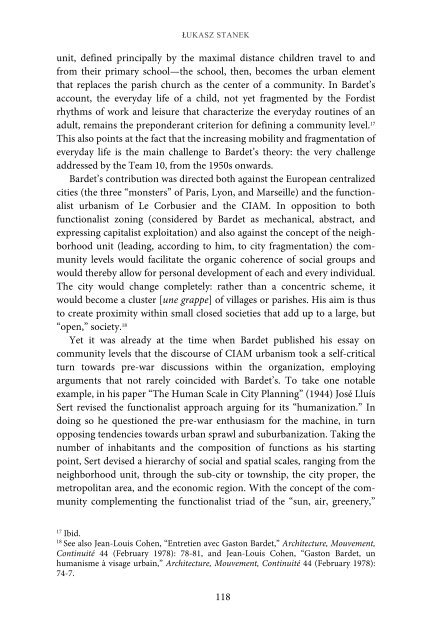Foucault, Biopolitics, and Governmentality
Foucault, Biopolitics, and Governmentality
Foucault, Biopolitics, and Governmentality
Create successful ePaper yourself
Turn your PDF publications into a flip-book with our unique Google optimized e-Paper software.
ŁUKASZ STANEK<br />
unit, defined principally by the maximal distance children travel to <strong>and</strong><br />
from their primary school—the school, then, becomes the urban element<br />
that replaces the parish church as the center of a community. In Bardet’s<br />
account, the everyday life of a child, not yet fragmented by the Fordist<br />
rhythms of work <strong>and</strong> leisure that characterize the everyday routines of an<br />
adult, remains the preponderant criterion for defining a community level. 17<br />
This also points at the fact that the increasing mobility <strong>and</strong> fragmentation of<br />
everyday life is the main challenge to Bardet’s theory: the very challenge<br />
addressed by the Team 10, from the 1950s onwards.<br />
Bardet’s contribution was directed both against the European centralized<br />
cities (the three “monsters” of Paris, Lyon, <strong>and</strong> Marseille) <strong>and</strong> the functionalist<br />
urbanism of Le Corbusier <strong>and</strong> the CIAM. In opposition to both<br />
functionalist zoning (considered by Bardet as mechanical, abstract, <strong>and</strong><br />
expressing capitalist exploitation) <strong>and</strong> also against the concept of the neighborhood<br />
unit (leading, according to him, to city fragmentation) the community<br />
levels would facilitate the organic coherence of social groups <strong>and</strong><br />
would thereby allow for personal development of each <strong>and</strong> every individual.<br />
The city would change completely: rather than a concentric scheme, it<br />
would become a cluster [une grappe] of villages or parishes. His aim is thus<br />
to create proximity within small closed societies that add up to a large, but<br />
“open,” society. 18<br />
Yet it was already at the time when Bardet published his essay on<br />
community levels that the discourse of CIAM urbanism took a self-critical<br />
turn towards pre-war discussions within the organization, employing<br />
arguments that not rarely coincided with Bardet’s. To take one notable<br />
example, in his paper “The Human Scale in City Planning” (1944) José Lluís<br />
Sert revised the functionalist approach arguing for its “humanization.” In<br />
doing so he questioned the pre-war enthusiasm for the machine, in turn<br />
opposing tendencies towards urban sprawl <strong>and</strong> suburbanization. Taking the<br />
number of inhabitants <strong>and</strong> the composition of functions as his starting<br />
point, Sert devised a hierarchy of social <strong>and</strong> spatial scales, ranging from the<br />
neighborhood unit, through the sub-city or township, the city proper, the<br />
metropolitan area, <strong>and</strong> the economic region. With the concept of the community<br />
complementing the functionalist triad of the “sun, air, greenery,”<br />
17 Ibid.<br />
18 See also Jean-Louis Cohen, “Entretien avec Gaston Bardet,” Architecture, Mouvement,<br />
Continuité 44 (February 1978): 78-81, <strong>and</strong> Jean-Louis Cohen, “Gaston Bardet, un<br />
humanisme à visage urbain,” Architecture, Mouvement, Continuité 44 (February 1978):<br />
74-7.<br />
118


